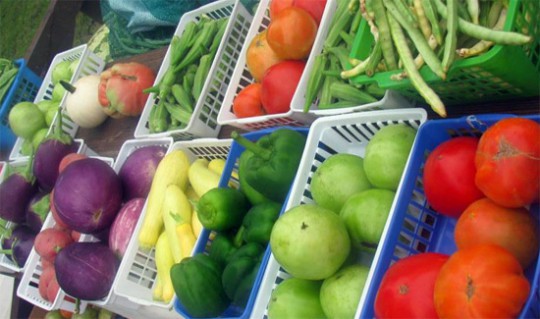Local Fresh Food Becoming More Popular; Farmers’ Markets This Saturday
September 6, 2013
Floridians are buying more food grown locally or regionally and retail sales are higher here than in other states, according to a University of Florida study.
It showed local food represents about 20 percent of all Florida food purchased for at-home consumption, except restaurant take-out food, said Alan Hodges, an Extension scientist with UF’s Institute of Food and Agricultural Sciences.
 In addition to local farmers and roadside stands, farmers’ markets are a good source for local food. For information on two local markets this weekend, see the box to the left.
In addition to local farmers and roadside stands, farmers’ markets are a good source for local food. For information on two local markets this weekend, see the box to the left.
The study was based on a statewide consumer survey. Prior estimates from other states had local food accounting for about 5 percent of all food sales, he said.
“We are doing relatively better in Florida, in moving toward food self-sufficiency,” Hodges said. “I can only attribute that to the favorable year-round growing conditions we have for fruits and vegetables.”
Hodges’ study is part of a larger project that involves consumer preferences about local food, said Tracy Irani, a UF professor of agricultural education and communication and development director for the Center for Public Issues Education, or the PIE Center.
Irani and graduate assistant Joy Goodwin headed the portion of the project that examined consumer preferences. Irani said data suggest local food sales might be up because consumers are paying closer attention to the things they eat, due to nutrition and health coverage in the media.
Increased awareness results in increased sales, she said. However, consumer participants said their purchase of local food would be likely to increase with increased advertising and marketing of local foods.
“Consumers perceive that there are health, quality and economic benefits to locally grown,” Goodwin said. “That will continue to motivate purchase behavior, all other things being equal.”
Projections based on the statewide consumer survey indicate that local food sales in Florida totaled $8.3 billion in a one-year period. An estimated $6.1 billion was spent at grocery stores but only $320 million in restaurants, Hodges said.
“Restaurants have huge potential there to buy locally produced meats, vegetables and other items,” Hodges said. “My suggestion is, if you want to see more local food on the menu at your favorite dining spot, ask for it.”
Some highlights of the results:
- Two-thirds of respondents said someone in the household bought local food at least once in the previous year.
- Among all Florida households, 62 percent bought local foods at farmers’ markets, 53 percent from retail supermarkets, 28 percent from restaurants, and 5 percent from community-supported agriculture or other direct transactions.
- The average spent on local food was $1,114 per household. That number was higher in Central and North Central Florida, compared with South Florida or the Panhandle.
- Almost three-fourths of the total estimated revenue — $6.1 billion –- was spent on local food at retail grocery stores. Consumers also spent $1.8 billion at farmers’ markets, roadside stands and U-pick farms. Restaurants and other food-service establishments accounted for $320 million, and other prearranged farm-to-consumer sales totaled $103 million.
Because there is no accepted definition of what constitutes “local” food, Hodges’ survey allowed respondents to define the term – and most often defined it as food produced within 100 miles of the consumer, he said.
Pictured top: Local produce available recently at the Market at St. Monica’s in Cantonment. The market is open the first and third Saturday of each month through October. Courtesy photo for NorthEscambia.com, click to enlarge.




Comments